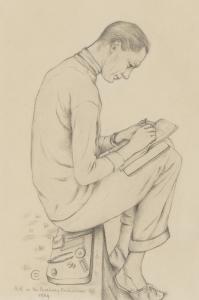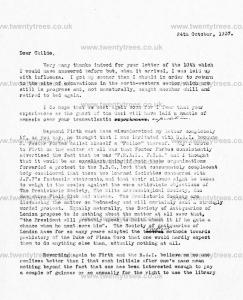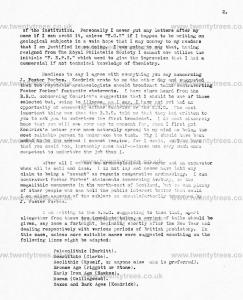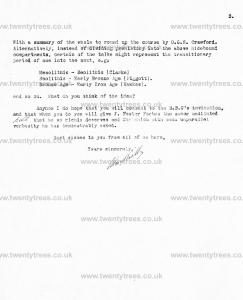Biography of Alexander Keiller 1889-1955
Paternal Family Tree: Keiller
Alexander Keiller 1889-1955 is in Archaeologists.
On 01 Dec 1889 Alexander Keiller was born to John Mitchell Keiller (age 38) and Mary Sime Greig (age 27).
On 02 Jan 1899 [his father] John Mitchell Keiller (age 48) died.
The Evening Telegraph, Friday January 6, 1899
The late Mr John M Keiller
The intimation of the death of Mr John M Keiller, of the firm of Messrs James Keiller & Son, Limited, preserve manufacturers, Dundee, has caused widespread regret throughout the city and district. Deceased was a comparatively young man, being still in the prime of manhood, and although his health of late has necessitated frequent periods of rest, it was hoped his retiral from active work was only temporary. Since leaving Dundee Mr Keiller has resided chiefly in London, but took frequent voyages on board his yacht the Erl King for health purposes. A short time ago he left this country for Madeira, and towards the end of the year he sailed for the West Indies. He died on Monday - the day after the anniversary of his birthday - at sea, but no details as to the sad event have yet been received.
Though only in his 49th year, deceased has had a fairly long and active career. Through the death of his father, when the son was 26 years of age, he was unexpectedly called upon to conduct a business which was the largest of its kind in the country. Born in 1851 in Dundee on New Year's Day he, like most young Dundonians who have occupied prominent positions in the mercantile life of the community, was sent to the High School, where he received his early training. He then went to Edinburgh University, and afterwards spent two years on the Continent for the purpose of perfecting his knowledge of the French and German languages. It is worthy of note that he did this at a time when foreign languages were not held in the esteem they are nowadays, but he evidently could appreciate the advantage familiarity with these tongues would be to him in the development of the Continental part of the business. Returning to Dundee, he entered his father's office, and set himself with commendable industry, to master the details of the business. The knowledge thus gained was not long in being put to the test, and when he was called upon to take full charge of the affairs of the firm he soon showed that the ability which the concern had never wanted during the whole of its existence would not be lacking now. The firm, it may be said, was founded in 1797 by James Keiller, the grandfather of deceased, to whom the public owe the famous Dundee marmalade. At first the business was purely local, but a larger public was not long in appreciating the virtues of the new delicacy. The demand rapidly increased and additions to the capacity for producing marmalade had to be made from time to time. The principal difficulty in the early days had reference to the Sugar Import Duties, which, by keeping up the price of that indispensable ingredient of preserves, prevented the expansion of the trade which the abolition of the duties eventually allowed. In order to meet Continental competition under these disadvantageous circumstances, Messrs Keiller established a branch of their work in the island of Guernsey, where, on account of the fiscal arrangements between Great Britain and the Channel Islands, sugar was received free of import duties. The manufacture there of an article superior to the Continental make enabled the firm to successfully compete in the foreign markets. With the repeal of the sugar duties the necessity of keeping up an establishment in Guernsey disappeared, and the present works at Silvertown, London, were secured, the majority of the workpeople at Guernsey being transferred to the metropolis.
Though a prominent citizen of Dundee, Mr Keiller cannot be said to have been a public man in the usual acceptation of the term. For a short time he was a member of the Harbour Trust, and was also a past President of the Chamber of Commerce. He had no inclination for competitive elections, and did not seek admission to the Town Council or any of the other public Boards; but to took a warm interest in his native city, and by means of his private munificence and valuable counsel many an Insstitution was enabled to extend its work. Since 1895, however, when the firm was converted into a limited liability Company, Mr Keiller has not been seen much in Dundee. He gave up his town residence at Binrock and went to live in London, but he has spent the most of his life since then at sea. He was perhaps best known to Dundonians as a lover of the fine arts and a warm supporter of the Art Gallery. He contributed £1000 towards the building fund of the Institution, and in commemoration of the Queen's Jubilee he handed over a sum of £10,500 for the purpose of clearing off the debt of the Albert Institute and erecting an Art Gallery. He by this means put the Free Library Committee in possession of funds which enabled them to do much to extend the usefulness of that institution. New books were secured for the Reference Library, and in other ways his liberality found suitable expression. He was an extensive purchaser of pictures for himself, and his house at Binrock was the home of a fine collection of works of leading artists. He made more than one artistic gift to the public galleries, including the two-thirds life-size marble statue of Hamlet, the work of Senor Weisenberg, and the picture of "The Swineherd", by W.E. Lockhart, R.S.A. - two works which are familiar to all frequenters of the Art Galleries. Among his other benefactions to the city may be mentioned a challenge cup and medal to encourage gymnastics, and a donation of £2000 to the Infirmary. In 1886 he purchased the Morven and Gairnside portion of the Marquis of Huntly's Aboyne estates, on which he built a mansionhouse close to Ballater. He married the eldest daughter of the late Dr Greig, and is survived by a widow and son nine years of age. He was a Conservative in politics, and a supporter of the Church of Scotland.
On 22 Jan 1907 [his mother] Mary Sime Greig (age 44) died.
On 02 Jun 1913 Alexander Keiller (age 23) and Florence Marianne Phil-Morris (age 30) were married.
In 1914 Alexander Keiller (age 24) joined the Royal Naval Volunteer Reserve as a temporary lieutenant, moving to the Royal Naval Air Service in December 1914. He was invalided out of service in 1915.
After 1918 Alexander Keiller (age 28) and Florence Marianne Phil-Morris (age 35) were divorced.
In 1924 Alexander Keiller (age 34) bought Windmill Hill Causewayed Enclosure [Map] and excavated between 1925 to 1929 with Harold St George Gray (age 51). Pottery was found in the bottom of the ditches - probably Windmill Hill Pottery. Upper layers contained Peterborough Ware. Later deposits contained Grooved Ware and Beaker Potsherds suggesting continuous occupation over an extended period.
Wessex from the Air. Wessex From The Air by O. G. S. Crawford (age 41), F.S.A. And Alexander Keiller (age 38) F.S.A., F.G.S. 1928.
 1934. [his future wife] Doris Emerson Chapman (age 31). Drawing of the artist's future husband Alexander Keiller (age 44).
1934. [his future wife] Doris Emerson Chapman (age 31). Drawing of the artist's future husband Alexander Keiller (age 44).
Antiquity 1936 Volume 10 Issue 40 Pages 417-427. The Recent Excavations at Avebury by Alexander Keiller (age 45) and Stuart Piggott (age 24).
Keiller Collection Letters 24 Oct 1937. 24th October, 1937. Alexander Keiller (age 47) to Vere Gordon Childe (age 45).
Dear Childe,
Very many thanks indeed for your letter of the 10th which I would have answered before but, when it arrived, I was up with Influenza. I got up sooner than I should in order to return to the site of excavations in the north—weetern sector which are still in procreee and, not unnaturally, caugnt another chill and retired to bed again.
I do hope that we meet soon for I fear that your experiences as the guest of the Gazi will have laid a mantle of amnesia over your transatlantic [?].
Raymond Firth must have misunderstood my letter completely if, as you say, he though that I was irritated with R.A.I. becauoe J. Foster called himself a "Fellow" thereof. Why I wrote to Firth on the matter at all was that Foster Forbes (age 48) consistently advertised the fact that he was "F.R.A.I., F.S.A." that it would be an excellent thing both these organisations forwarded a protest to the B.B.C., lest that consumately complacent body considered that these two learned Societies concurred with J.F.F.s fantastic statements, and that their silence might be taken to weigh the scales against the more articulate objctions of The Prehistoric Society, The Wilts Archaeological Society, The Hampshire Field Club and others. The Prehistorlc Society are discussing the matter on Wednesdat and will certainly send a strongly worded protest. Equally naturally, the Society of Antiquaries of London propose to do nothing about the matter at save that. "the President wili probably speak to Reith about it if he a chance when he next sees him". The Society of London have for so many yeare adopted the methods towards prehistory of the Duke of Plaza Toro that one would hardly expect them to do anything else than, actually nothing at all.
Reverting again to Firth and the R.A.I. believe no one realises better than I that such initials after one'e nane mean nothing beyond the fact that one hae been interested enouch to pay a couple of guineas or so annually for the right to use the library of the Institution. Personally I never put any letters after my name if I can avoid it, unless F.G.S. if I happen to be writing on geological subjects iun a vain hope that I may convey to my readers I that I am justified in doing so. I was going to say that, having resigned from The Royal Philatelic Society I cannot now utilise the initials "F.R.P.S." which used to give the impression that I had a commercial if not technical knowledge of Chemistry.
Needless to say I agree with everything you say concerning J. Foster Forbes (age 48). Kendrick wrote to me the other day and suggested that two reputable arehaeologists should broadcast talks contraverting Foster Forbe's fantastic statements. I have since heard from the B.B.C. concerning Kendrick's suggestion that I should be one of those selected but, owing to illness, as I say, I have not yet had an opportunity of answering either Kendrick of the B.B.C. The most important this was that the B.B.C. told me they had writted to you to ask you to undertake the frist broadcast. I do most sincerely hope that you will see your way to consent for, when I first got Kendrick's letter your name naturally sprang to my mind as being the most suitable person to undertake the task. Why I should have asked to be the second I cannot imagine, for i could, as I am sure that you could too, instantly name half-a-dozen men very much more competent to undertake the job than I.
After all I but an archaeological surveyor and excavator when all is said and done. I do not lay and never have laid claim to being a "savant" as regards comparative archaeology. I can contravert Foster Forbes' (age 48) statements concerning Avebury, or the megalithic monuments in the north—east of Scotland, but so can plenty of other people who can hold the publie interest better than could I on wider aspects of the subjecty so unsatisfactorily traversed by J. Foster Forbes (age 48).
I am writing to the B.B.C. to suggesting to them that, apart altogether frocu these two immediate talks, a series of talks should be given, say once a fortnight, beginning shortly after the New Yeur and dealing respectively with various periods of British prehistory. In this case, unless more suitable names ware suggested something on the following lines might be adopted:
Palaeolithic (Burkitt).
Mesolithic (Clarke).
Neolithic (Myself, or anyone else who is preferred).
Bronze Age (Piggott or Stone).
Early Iron Age (Hawkes).
Roman (Collingwood).
Saxon and Dark Agee (Kendrick) .
With a summary of the whole to round up the course by O.G.S. Crawford. Alternatively, instead of dividing prehistory into the above hidebound compartments, certain of the talks might represent the transitionary period of one into the next,
Mesolithic — Neolithic (Clarke)
Neolithic — Early Bronze Ace ( Pit.•gott).
Bronze Age — Early Iron Ace (Hawkes).
and so on. Whnt do you think of the Idea?
Anyhow I do hope that you consent to the B.B.C's invitation, and that when you do you will give J. Foster Forbes the sheer undiluted hell that he so richly deserves and for which with sucg unparallel verbosity he has demonstrably asked.
Best wishes to you from all of us here,
Yours sincerely
John Foster Forbes: In 1889 he was born at Rothiemay Castle, Aberdeenshire. In Jul 1958 he died in the Brighton General Hospital after complications following an operation for peritonitis.



1938 to 1939. Keiller's Slides comprise 550 Slides taken by Alexander Keiller (age 48) during the archaeological work undertaken between 1938 and 1939. They show general views around the henge and along West Kennet Avenue, both before and after restoration work. Others show the excavation of banks and ditches and the re-erection of stones in progress. There are also several slides which depict maps and plans of the area, archaeological finds from the site.
On 16 Nov 1938 Alexander Keiller (age 48) and Doris Emerson Chapman (age 35) were married.
Antiquity 1939 Volume 13 Pages 223-233. Avebury [Map]. Summary of Excavations, 1937 and 1938 by Alexander Keiller (age 49).
Note 1. See Plate I, facing p. 232. My thanks are expressed to Major Allen for permitting the use of this air-photograph.
In 1951 Alexander Keiller (age 61) and Doris Emerson Chapman (age 48) were divorced.
In or after 1951 Alexander Keiller (age 61) and Gabrielle Muriel Ritchie (age 42) were married. His fourth marriage; her third.
In 1955 [his former wife] Florence Marianne Phil-Morris (age 72) died.
On 29 Oct 1955 Alexander Keiller (age 65) died.
03 Dec 1955. Nature. Obituaries. Source
Mr. Alexander Keiller.
ALEXANDER KEILLER, who died at the end of September at the age of sixty-five, was one of the long line of distinguished amateur British archæologists which goes back to Aubrey and Stukeley. Of these perhaps the greatest was Pitt-Rivers, on whom Keiller, like him with leisure and abundant means at his disposal, admittedly modelled his own work.
While still in his early thirties, Keiller carried out a systematic survey of stone circles and allied morm ments in north-east Scotland, making accurate plans and detailed descriptions of each site. A summary account of this work was presented as a paper to the British Association at its Aberdeen meeting in 1934.
In 1925, however, he embarked on the programme of excavation and field-work with which his name will be inseparably associated. He acquired and began excavations on Windmill Hill, near Avebury in north Wiltshire, and continued these annually until 1929, revealing in detail the first extensive Neolithic settlement to be explored in Britain. The material was housed in a museum in his London house, where it was at the disposal of students, and as a result the earliest Neolithic culture of southern Britain, taking its name from the type-site, was defined and clarified.
From Windmill Hill to tho Avebury monuments themselves was an inevitable step, and in 1933 Keiller began a systematic excavation programme with the oxarnination of the northern part of the West Kennet Circle itself. Avenue, continuing until 1938 within the Great Circle itself. He moved his residence to Avebury Manor, and re-housed his museum within its grounds, making it and the excavated portions of the monument available to the public. He adopted a policy of imaginative but judicious conservation and, restoration of the Avebury monuments, and system atically purchased land to preserve these and their surroundings; as a result it was eventually possible for the whole area to be acquired by the National Trust and the Ancient Monuments Department of the Ministry of Works.
Keiller's outstanding contribution to contemporary British archreology was his insistence on high standards of discipline and accuracy in excavation and field-work, and his realization from the first of the value of scientific techniques as applied to archreo logical material. He early appreciated the potential ities of air photography, collaborating with Crawford in the "Wessex from the Air'' survey, and even discussing with Eckener the possibility of using the Graf Zeppelin for a similar but even more ambitious scheme. At Windmill Hill he insisted on a full study of the faunal and floral remains in their archreological context. But above all it is to Keiller that we owe the inception of the systematic study of British prehistoric stone artefacts by petrographical means, which, following his lead, is now yielding information of the highest importance on manufacture and trade in the early second millennium B.C. Alec Keiller was an enthusiast in the best sense; full of ideas, stimulating and highly individual. Archæology, like other academic disciplines, can only benefit from the impact of such men.
STUART PIGGOTT (age 45)
In 1990 [his former wife] Doris Emerson Chapman (age 87) died.
On 23 Dec 1995 [his former wife] Gabrielle Muriel Ritchie (age 87) died.
Great x 1 Grandfather: James Keiller
GrandFather: Alexander Keiller
Father: John Mitchell Keiller
Mother: Mary Sime Greig